It is impossible not to fall in love with Paris. The city's people are stylish and flirtatious, its architecture seductive, its restaurants and nightlife devoted to the pursuit of pleasure and its streets are scattered with dreams.
There is no 'best time' to visit Paris; in every season the city is always alive. Summer days are spent lazing on the banks of the Seine, sipping coffee at a sidewalk café, or idling in one of the city's many gardens or forests. In autumn afternoons the brisk walk from the Eiffel Tower through the Parc du Champ de Mars and up to the glittering Champs Elysées is accompanied with a carpet of leaves crunching underfoot. Winter nights induce a warm glow ice-skating in the outdoor rink at the Hotel de Ville, and in spring the passions of performers fill the air outside the Pompidou Centre and the nose is tickled with the subtle scents of flowering gardens.
There is an otherworldliness to this city, where beauty and elegance are favoured over purpose and practicality. Centuries of urban development have the appearance of having being mastered by a single hand with a strong sense of balance, contrast and aesthetics. The views from the Eiffel Tower or Sacré Coeur reveal hundreds of iconic attractions for the snapshot visitor, but the best way to see this city is by tucking your map back in your pocket and allowing yourself to get lost on its streets and avenues, discovering the city for yourself.
However long you spend in Paris, on departure you will know you are sure to return.
Events
Paris - Right bank of Seine river
Two thousand tons of sand and some palm trees is all that is needed to annually transform the right bank of the Seine into a manmade beach worthy of the French capital. The Paris Plage (Paris Beach) is a highly popular, free 'event' instituted by the City Fathers in 2002 that attracts millions of visitors to its shores. Between July and August, land-locked city dwellers can enjoy sun, fun and themed activities, without the usual Parisian price tag. A recent addition is a large swimming pool - good news for those seeking some relief from the summer sun, especially as the dirty water of the Seine itself is not a welcome thought.
| | 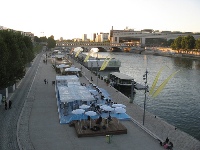 |
Paris - Roland-Garros Stadium
Together with Wimbledon, the Australian Open and the US Open, the French Open is one of the four events that together are known as the tennis 'Grand Slam'. The tournament has become the most highly prized clay court title in the world and one of the biggest sporting events in France. Besides the best tennis players in the world, the stadium is also the place to be seen for the fashion conscious. | | 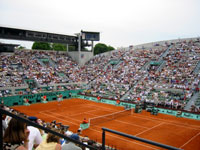 |
Paris
For one night in Paris the idea is to stay awake and partake in the observance of night. Many public services, entertainment facilities and tourist attractions, cafes, bars and restaurants stay open throughout the night to keep people awake. The white nightis a celebration of human culture and communication and encourages people to enjoy one another's company, as it is often subjugated in favour of the daytime rat race.
| | 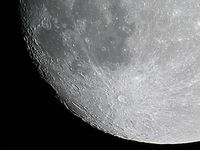 |
Paris - Le Golf National
A popular event on the PGA European Tour, the Open de France is the oldest tournament in continental Europe, and along with the American PGA Tour is the richest and most illustrious golfing competition in the world.
| | 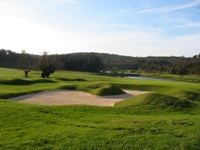 |
Paris - Various
Every year on the summer solstice, Paris hosts amateur and professional musicians who perform in a variety of venues around the city, from public squares, streets and parks to opera houses and castles. The festival aims to celebrate music in all forms and is open to anyone. A large free concert is traditionally held featuring some big names in the music world, but on every corner, in doorways, in restaurants and hospitals, museums and courtyards, there are the sounds of music, from jazz, salsa and techno, to choirs, orchestras and steel bands, accompanied by people dancing, eating and drinking. |
| 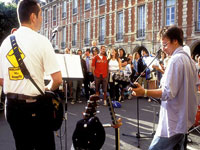 |
| Prix de l'Arc de Triomphe |
Paris - Longchamp Racecourse
The Arc de Triomphe is France's premier horse race and attracts thoroughbreds and racing enthusiasts from all over the world. Since its inaugural race in 1920, the Prix de l'Arc de Triomphe has become established as the all-aged middle-distance championship of Europe. | | 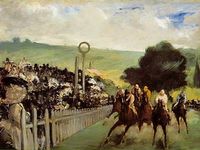 |
Paris
Held every autumn, the arts festival is a showcase for contemporary art in all forms from around the world, including theatre, film, music, dance, sculpture and literature, and is the largest festival of its kind in the world. Special attention is given to foreign culture as well experimental work and the development of new talents. | | 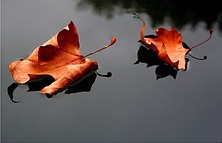 |
Paris - Start - Rotterdam; Finish - Paris (Champs-Elysées)
What started off as a far-fetched, unimaginable idea dreamed up by two gentlemen in a Parisian brasserie in 1902, has a century later grown into the world's greatest bicycle race, indeed considered by many to be the greatest annual sporting event on earth. The unique spectacle is ingrained in France's heritage, traditionally ending in Paris, and draws hundreds of local and international cyclists in a battle for dominance over 2,175 gruelling miles (3,500km) every year. The race is split into 21 daily stages and completes a clockwise loop around the country, including treacherous mountain roads in the Pyrenees and the Alps. The famous yellow jersey is worn by the overall General Classification leader who maintains the lowest overall time. Every year the first stage of the race starts somewhere different, either in France or in another country.
| | 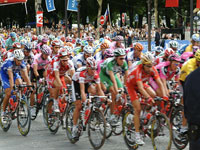 |
Paris - Metropolitan Pavillion & Altman Building
An annual festival in celebration of chocolate is a dream come true for chocoholics, and the large convention centre beneath the Louvre hosts just that. There are tastings and chefs demonstrations at a huge variety of international chocolatiers stands; opportunities to sample and buy goodies such as truffles, chocolate-dipped fruit kebabs, hot chocolate and cakes; as well as chocolate fashion, sculpture and art. Exhibitions include the history of chocolate, books on chocolate and desserts, and an antique collection of 'teapots' used exclusively for hot chocolate. A Chocoland for children entertains with chocolate makeup and other delicious activities. | | 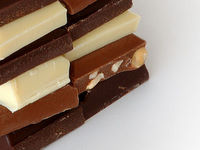 |
| Bastille Day Celebrations |
Paris - Champs Elysees and Place de la Bastille
France's most important national holiday, Bastille Day commemorates the beginning of the French Revolution with ceremonies, dancing, parties and balls all over the city. In the morning there is a grand military parade along the Champs Elysees, accompanied overhead by jet formations, and after the day-long festivities, a fireworks display takes place near the Eiffel Tower. | | 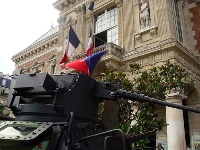 |
| World Circus Festival of Tomorrow |
Paris - Cirque Phenix
The annual Circus Festival provides an unequalled opportunity to see top international circus performers from famous schools together under one roof, including acts from the Beijing Circus, the Moscow Circus, the Knie Circus and local talent Ecole Fratellini. The aim is to bring together young acrobats, animal trainers and clowns and to reveal new and exciting trends in circus acts from traditional, modern and experimental circus performances.
| | 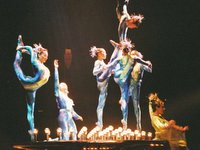
|
Attractions
The Picasso Museum is situated in a 17th century mansion in the heart of Paris. The collection was started in 1973, after the French government accepted Picasso's own collection in lieu of death duties, and was added to after his widow's death in 1990. All the phases of work from the Paris-based artist are represented including his paintings, drawings, ceramics, sculptures and even poetry. Memorable works include the self-portrait Paolo as Harlequinand Nude in an Armchair. Most of Picasso's great paintings however are owned by and housed in foreign museums or are in the hands of private collectors.
| | 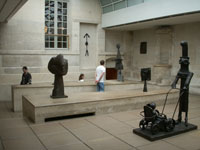 |
In the 16th century, Henry II and Catherine de Medici commissioned architects Philibert Delorme and Jean Bullant to build a new palace here within the Fontainebleau forest 40 miles (64km) south of Paris. Italian Mannerist artists Rosso Fiorentino and Primaticcio came to assist in the interior decoration, helping to found the School of Fontainebleau. Visitors will see the long Gallery of François I, which the artists adorned with scenes like The Rape of Europaand the monarch holding a pomegranate, a symbol of unity, as well as the richly adorned Louis XV Staircase and the Ballroom with its monumental fireplace and frescoes. The palace was a refuge for French monarchs from the days of the Renaissance; they valued it because of its distance from the slums of Paris and for the rich hunting grounds that surrounded it. Many important events have occurred here, perhaps none more memorable than when Napoleon stood on the grand steps in front of the palace and bade farewell to his shattered army before departing for Elba. Compared to the glories of Versailles, however, Fontainebleau can be a bit of an anticlimax; it is best to see it before Versailles.
| | 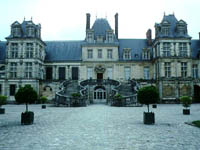 |
The Château de Versailles stands 15 miles (24km) southwest of Paris and is one of France's noted attractions. Most of the palace was built between 1664 and 1715 by Louis XIV (known as the Sun King), who turned his father's hunting lodge into the grandest palace ever built. The 'Old Château' still exists but is enveloped by the vast white stone façade of the New Château. This lavish statement of monarchical power was to become a symbol of the excess that would lead to the revolution of 1789. Perhaps the most famous room in the palace is the Hall of Mirrors (Galerie des Glaces) where the Treaty of Versailles was signed, signifying the end of the Great War. Within the palace visitors can also see the former Royal bedchambers, the grand staircase and other staterooms, and within the vast landscaped park and gardens are many wonderfully ornate fountains and ponds. There is a small train that ferries visitors from the palace to the Grand Trianon and Petit Trianon, former love nests where both the Sun King and Napoleon enjoyed the company of their mistresses.
| | 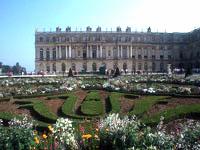 |
Built in the 1970s and named after former French president Georges Pompidou, the futuristic Pompidou Centre is now considered part of the Parisian landscape. The outrageous design, complete with its glass elevators, was the inspiration for the Lloyds Building in London and attracts visitors by the million; it is the city's most popular attraction by far. The building houses the Musée National d'Art Modern (MNAM), which displays a vast collection of 20th-century art from Fauvism and Cubism to Abstract and Absurd and its numerous cinemas and theatres have regular musical and dance performances. The square to the West of the building attracts a varied assortment of street performers.
| | 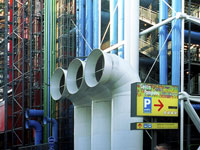 |
Gustave Eiffel, the architect of the Eiffel Tower (Tour Eiffel) could never have guessed that it would become Paris's signature sightseeing attraction and bring more than six million visitors a year. It was built as a temporary structure to commemorate the centenary of the French Revolution and was opened by the Prince of Wales, later King Edward VII of England. The Eiffel Tower was considered an eyesore by many and there were petitions to have it pulled down. It was saved only because it had become an important antenna for telegraphy. It towers 984ft (300m) above the Champ de Mars and until 1930 was the world's tallest building. The highest of its three levels offers a wonderful panoramic view over Paris.
| | 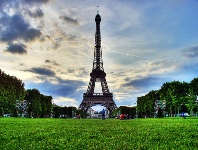 |
One of the world's great art museums, this vast edifice houses an extraordinary collection of paintings, sculptures and antiquities from all over the world. The Louvre was opened to the public in 1793, soon after the Revolution, to display the spectacular treasures looted from the royal palaces. The best-known attraction is Leonardo da Vinci's enigmatic Mona Lisa, which is protected by bullet-proof glass within its own room. The permanent collections are divided into Egyptian, Greek, Roman and Asian antiquities, painting, drawings, sculpture and objects d'art. Don't even attempt to see it all in one day.
| | 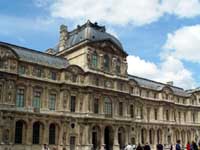 |
This great museum is fairly new by Paris standards. It is situated in a railway station by the Seine and houses a vast collection of works from the significant 1848 to 1914 period. There are important works from the Art-Nouveau movement but the Orsay is best known for its Impressionist and Post-Impressionist art. The collection is arranged chronologically and contains highly regarded works by Monet, Manet and Courbet. Also on permanent display is the famous painting by Gustave Doré entitled L'énigmeand Henri Chapu's marble statue of Joan of Arc in Domrémy. The museum is undergoing construction on level 5 until March 2011.
| | 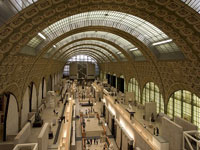 |
Notre-Dame looms large over the Place de Parvis, on the Isle de la Cité, and as the most enduring symbol of Paris is an alluring tourist attraction. Built between 1163 and 1345 the Cathedral is considered one of the of the world's Gothic masterpieces. The massive interior can seat 6,000 and it is dominated by three spectacular and enormous rose windows and a vast 7,800-pipe organ. The 387-step climb to the top of the towers is worth the effort for the panoramic view of the city and the close-up views of the famous gargoyles. The tower also holds the great bell that was rung by Quasimodo, the fictional hunchback. Opposite the north door is a museum that displays the Cathedral's history, while under the square in front of the Cathedral is the crypt that houses Notre-Dame's archaeological museum. For a special experience, visit Notre-Dame on a Sunday morning when Paris' museums are closed and services are being held.
| | 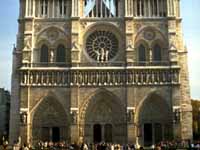 |
The Rodin Museum is situated near the Musée d'Orsay and is housed in what was formerly the Hôtel Biron, the beautiful hotel where Auguste Rodin (1840-1917) once lived and worked. Inside are many of Rodin's great marble sculptures including The Kisswhile outside, in the garden, are famous bronzes including The Thinker.The museum also includes many works by Camille Claudel, Rodin's pupil and mistress, and paintings by Van Gogh, Renoir, Manet and Rodin himself.
| | 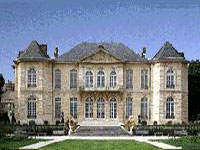 |
The world's largest triumphal arch, the Arc de Triomphe de l'Etoile is set at the centre of a star-shaped configuration of 12 radiating avenues. It stands 165ft (51 metres) tall and the names of major victories won during the Revolutionary and Napoleonic periods are engraved around the top of the Arch. The names of less important victories, as well as those of 558 generals, can be found on the inside walls. Since 1920, the tomb of France's Unknown Soldier has been sheltered underneath the arch. Its eternal flame commemorates the dead of the two world wars, and is rekindled every evening at 6pm. On July 14, the French National Day, also known as Bastille Day, a military parade starts at the arch and proceeds down the Champs Elysées.
| | 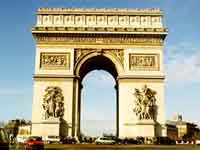 |
Les Invalides were built by Louis XIV in 1670 as a military hospital to take care of wounded soldiers. This attraction comprises the largest single collection of monuments and museums in Paris all relating to the military history of France. It is a burial site for some of France's war heroes, including the ashes of the greatest French military genius, Napoleon Bonaparte, rest under the dome of Les Invalides and attract many visitors to Paris. Its 13 hectares of building and large church with a golden dome make Les Invalides a classical French architecture masterpiece.
| | 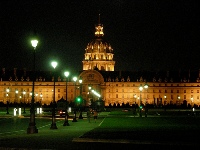 |
The Jardin des Plantes is France's main botanical garden. Covering 28 hectares (280,000 m²) the garden was originally planted by Louis XIII's doctor in 1626 as a medicinal herb garden. In 1640, it became Paris's first public garden. In 1739, after a long period of decline, the gardens were expanded greatly and a maze called the Labyrinth was added. It still exists today. The Jardin des Plantes maintains a botanical school which constructs demonstration gardens and trains botanists.
| | 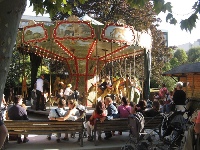 |
Comprising two theme parks, Disneyland Paris is a must for all children visiting the city. With all their favourite characters, exciting rides and much more, children of all ages will love Disneyland Paris. There are also seven Disney-owned hotels for visitors and holidaymakers to choose from to help make their Disneyland Paris experience one to remember.
| | 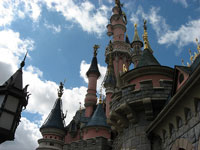 |
| Musée National d'Histoire Naturelle |
Located in the Jardin des Plantes, the Musée National d'Histoire Naturelle (Natural History Museum) greets visitors with two gigantic whale skeletons at the entrance. With wonderful exhibitions and fascinating displays on botany, archaeology and palaeontology to name a few, the museum will captivate kids' imaginations and educate them as well. The dinosaur exhibits is hugely popular with the younger visitors, but this museum is a must for children of all ages.
| | 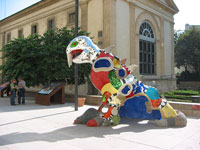 |
| Le Jardin d' Acclimatation |
This children's amusement park sees thousands of tourists every year. Featuring a menagerie and the Exploradome Museum, with fantastic optical illusions and amazing structures, the Jardin d'Acclimatation is a great place for kids to run around and let off some steam.
| | 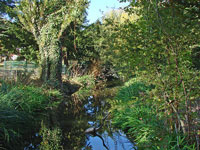 |
Based on the comics by Uderzo and Goscinny, the Parc Asterix, is a theme park located just outside of Paris. It's well known for its large variety of roller-coasters and has begun incorporating rides and themes from historic cultures such as the Romans and the ancient Greeks. The Menhir express is a log flume ride, while other rides include the Goudurix, the Grand Splatch and the Oxygénarium.
| | 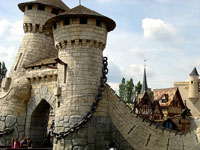 |
Located in Flancourt, France Miniature features over 130 models of famous French attractions, such as the Eiffel Tower, Lourdes and Versailles, for visitors to enjoy. Everything has been created a 1/30 scale and some for the models are even animated. Children will love spending a day out at this miniature country.
| | 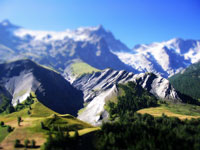 |
The largest water park in Europe and located in the heart of the city, Aquaboulevard is a great treat for kids on rainy days in Paris, as its facilities are indoors, with outdoor pools and a beach for when the weather is fine. The park itself includes waterslides and wave machines, with Jacuzzis for parents, but the complex also offers cinemas, tennis courts, a fitness centre, play areas, and other attractions.
| | 
|





























No comments:
Post a Comment